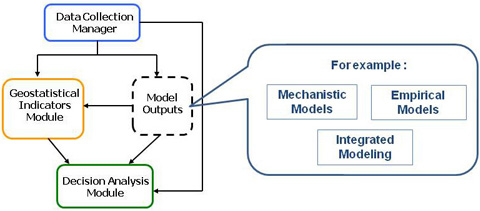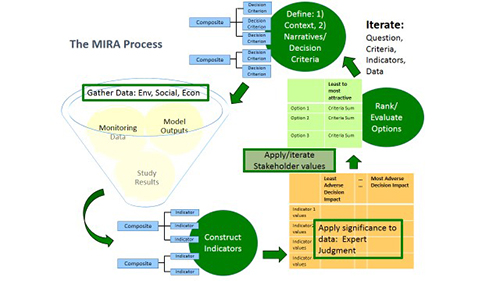Multi-criteria Integrated Resource Assessment (MIRA)
MIRA Overview
MIRA is an approach that facilitates stakeholder engagement for collaborative multi-objective decision making. MIRA is designed to facilitate and support an inclusive, explicit, transparent, iterative learning-based decision process.
The process is used to:
- Create an Environmental Index
- Rank environmental elements such as counties, watersheds or alternative decision options (using many indicators)
What kinds of analytical problems can MIRA handle?
- Policy/decision problems with many and diverse stakeholder interests
- Mix of quantitative and qualitative data/information, including chemical and non-chemical stressors and human health and ecosystem/ecosystem services
- Data/model uncertainties as well as decision uncertainty
- Policy/decision problems that utilize highly technical, expert information as well as stakeholder values
- Rank ordering and comparing things
MIRA is designed on these decision analytic principles:
- Consideration of Stakeholders
- Context
- Criteria and their metrics
- Significance of the data metrics
- Value judgments
Why should you use MIRA?
Environmental problems are complex and deciding what to do about them is complicated by diverse stakeholder perspectives, a combination of science, economic and socially relevant data/information, and sometimes, regulatory constraints. Defining the problem and finding the necessary common ground in which to make policy decisions are difficult. This is a wicked problem.
What’s wicked got to do with it?
All decision making problems are wicked problems. Environmental decision making problems typically also contain tame problem components (i.e., we want to use scientific data in decision making). Knowing which components are tame vs. wicked in the environmental decision making problem flags those components that are best resolved with mathematical and scientific data and models (elegant solutions) vs. those components that are best resolved with facilitated stakeholder discussion and the application of values (clumsy solutions).
Examples of Wicked Environmental Problems: Global climate change, Sustainability, Environmental risk management
Environmental Solutions: MIRA facilitates "clumsy" solutions
Clumsy solutions are those that exhibit the following features:
- Stakeholder-inclusive
- Transparent
- Learning-based
- Iterative
Learn more about how clumsy solutions work from Vermeij et al. 2006. Clumsy Solutions for a Complex World: The Case of Climate Change. Public Administration 84 (4): 817-843 and about how MIRA facilitates clumsy solutions.
MIRA Tools
The diagram below illustrates the tools in the MIRA Toolbox:

How the MIRA modules connect with each other and with outside information:
Data Collection Manager
- allows users to store, sort, and retrieve data such as source emissions, demographics, and environmental quality values
Geostatistical Indicators Module
- allows users to take spatial fields (i.e., maps) and collapse them into a single number in order to compare one map to another in making a decision
Programmatic and Budget Decision Analysis Module
- provides a way to organize all decision criteria (i.e., indicators), include expert opinions and include what's important to stakeholders in making a decision
- Model Outputs
outputs from Cause and Effect Models (from EPA and non-EPA sources) become inputs into MIRA; connects science with decision making (via the MIRA Decision Analysis Module) - Data for Environmental Modeling (D4EM):
D4EM interfaces National, Regional, State, Local and user defined databases with modeling systems, such as FRAMES. - Framework for Risk Analysis for Multimedia Environmental Systems (FRAMES):
- FRAMES allows models to communicate with each other, facilitating the passage of data, resulting in the simulation of complex environmental processes.
- Supercomputer for Model Uncertainty and Sensitivity Evaluation (SuperMUSE):
- SuperMUSE combines a software and hardware to allows analysts to select one or more components of the MIRA-FRAMES architecture depending on their analytical needs and also give them the capability to perform model uncertainty and/or sensitivity analysis.
- Mechanistic Models:
Explicitly include the mechanisms or processes between the state variables; unlike empirical models. The parameters in mechanistic models should be supported by data and have real-world interpretations (EPA, 2009b). Examples are Fate and Transport models like Air Quality Models (AERMOD, CMAQ) and Water Quality Models (HSPF, SWAT) - Empirical Models:
Rely upon the observed relationships among experimental data typically because information about the underlying mechanism is not understood or available. These can be thought of as ‘best-fit’ models whose parameters may or may not have real-world interpretation. Examples are probabilistic models like regression models and exposure models. - Integrated Modeling:
A systems analysis-based approach to environmental assessment. It includes a set of interdependent science based components (models, data, and assessment methods) that together form the basis for constructing an appropriate modeling system. The constructed modeling system is capable of simulating the environmental stressor-response relationships relevant to a well specified problem statement. (Integrated Modeling for Integrate Environmental Decision Making, EPA100/R-08/010) An example is integrated environmental modeling Technologies (iemTechnologies)developed by EPA’s National Exposure Research Laboratory (NERL). It is a suite of tools for integrated environmental modeling, including Data for Environmental Modeling (D4EM), Framework for Risk Analysis for Multimedia Environmental Systems (FRAMES), and Supercomputer for Model Uncertainty and Sensitivity Evaluation (SuperMUSE).
Steps of the MIRA Process
There are just 6 steps to the MIRA process, they include:
- Initialize/Define the Context
- Initialize/Define the Criteria/Narratives/Data and Organization of Indicators applicable to the Context
- Initialize/Apply significance to the data
- Initialize/Apply values
- Learning via iteration
- Understanding the consequences of each choice (i.e., decision uncertainty)
The diagram below illustrates the steps in the MIRA process.

MIRA Applications
The MIRA Applications page has been archived. Search for it at EPA Archives
